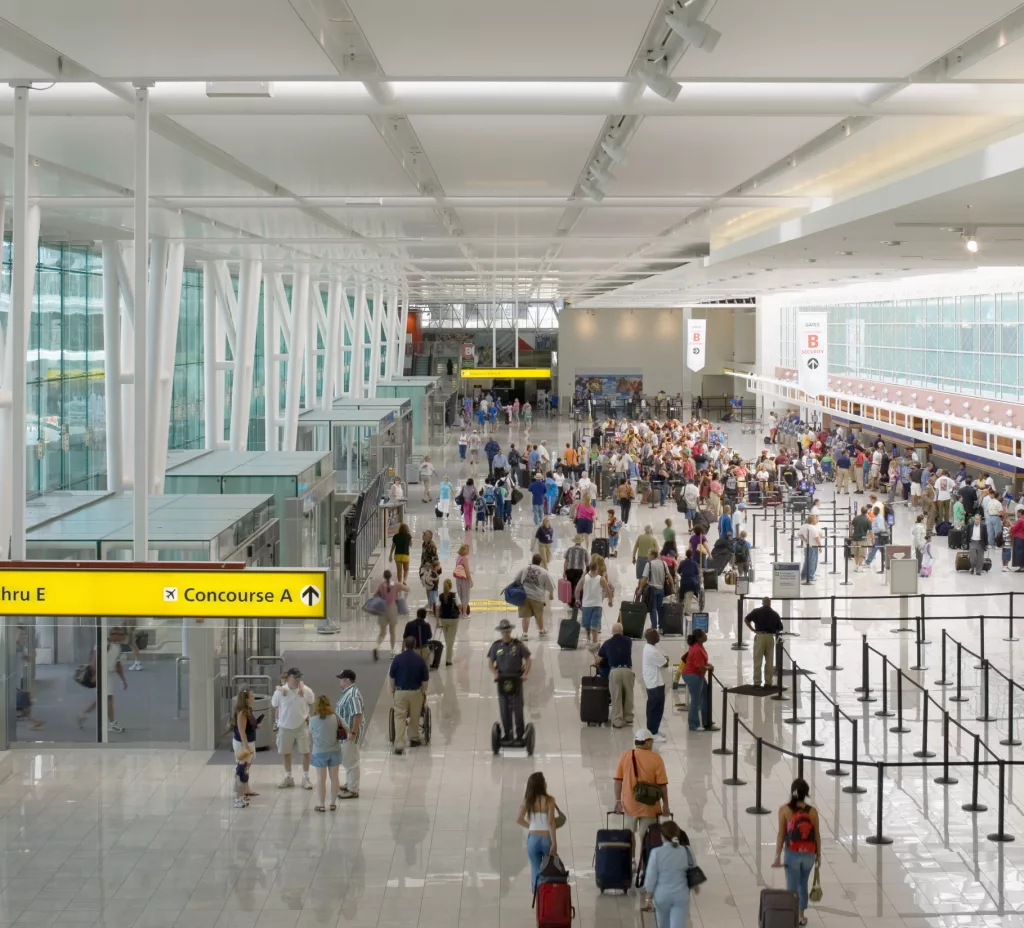
The U.S. Department of Homeland Security recently shared that the Transportation Security Administration has screened a record number of passengers in 2023.
In addition to the record number of screenings, TSA anticipates airport security checkpoints will be busier than ever this holiday travel season.
TSA expects to screen 30 million passengers during the Thanksgiving travel period alone.
The administration shares that, historically, the three busiest travel days have been the Tuesday and Wednesday before Thanksgiving and the Sunday after.
TSA has projected to screen 2.6 million passengers on Tuesday, Nov. 21; 2.7 million passengers on Wednesday, Nov. 22 and 2.9 million passengers on Sunday, Nov. 26.
TSA shares they expect the Sunday after Thanksgiving to be the busiest travel day.
Speaking on the estimated influx of travelers, TSA Administrator David Pekoske says:
“We expect this holiday season to be our busiest ever. In 2023, we have already seen seven of the top 10 busiest travel days in TSA’s history,” TSA Administrator David Pekoske said.
“We are ready for the anticipated volumes and are working closely with our airline and airport partners to make sure we are prepared for this busy holiday travel season.
We will also do our best to maintain wait time standards of under 10 minutes for TSA PreCheck lanes and under 30 minutes for standard screening lanes.”
According to the department, in 2023 alone, TSA has recorded multiple days with over 2.8 million passengers.
The department adds the current record for the heaviest passenger screening volume in TSA history was set on Friday, June 30.
On June 30, Transportation Security Officers screened nearly 2.9 million passengers at checkpoints nationwide.
TSA will likely exceed this record this Thanksgiving holiday travel period.
Travelers should keep these top tips in mind before
1. Pack smart; start with empty bags.
Passengers who start with an empty bag while packing are less likely to bring prohibited items through the checkpoint.
Certain foods, such as gravy, cranberry sauce, wine, jam and preserves, must be packed in a checked bag because they are considered to be liquids or gels.
If you can spill it, spray it, spread it, pump it or pour it, then it is a liquid and must be packed in your checked bag.
As always, passengers may bring solid foods such as cakes and other baked goods through the TSA checkpoint. Check for prohibited items by using the “What Can I Bring?” page on TSA.gov
2. Bring an acceptable ID and have it out in the screening lane.
Before heading to the airport, travelers must make sure they have acceptable identification.
Identity verification is an important step in the security screening process.
3. Arrive early.
The airport will be busy this week, so arrive two hours prior to your scheduled flight to allow for adequate time to park your car or arrive via public transit or rideshare, check bags and go through security screening before arriving at the gate.
4. Firearm Rules and Safety
If you plan to travel with a firearm, you must properly pack the firearm in a hard-sided, locked case in your checked bag and declare it with the airline at the ticket counter when checking in.
Passengers are prohibited from packing firearms in carry-on luggage and bringing them to the airport security checkpoint and onboard aircraft.
Bringing a firearm to a TSA checkpoint is expensive and time-consuming and can cause delays. The maximum civil penalty for bringing a firearm to a TSA checkpoint is nearly $15,000. Additionally, it will result in the loss of TSA PreCheck eligibility for up to five years. For more information on transporting firearms, visit: www.tsa.gov/travel/transporting-firearms-and-ammunition.
5. Be aware of new checkpoint screening technology.
TSA uses a variety of security methods and technologies to secure our transportation systems.
Screening protocols vary from airport to airport, depending on available technology and the current threat environment.
Some airports have installed new state-of-the-art Computed Tomography scanners which significantly improve threat detection capabilities for carry-on bags and reduce physical searches of bag contents for prohibited items.
6. Travel with ease with TSA PreCheck and ensure you have the TSA PreCheck mark on your boarding pass.
TSA’s trusted traveler program now has more than 90 participating airlines, is available at more than 200 airports and has two authorized enrollment providers.
Those enrolled enjoy the benefits of faster checkpoint screening.
The five-year membership costs just $78.
Most TSA PreCheck members wait less than five minutes at the checkpoint.
For more information about becoming a member of the TSA PreCheck program, visit: www.TSA.gov/precheck.
7. Call ahead to request passenger support.
Travelers or families of passengers who need assistance may call the TSA Cares helpline toll-free at 855-787-2227 at least 72 hours prior to travel with any questions about screening procedures and to find out what to expect at the security checkpoint.
TSA Cares also arranges assistance at the checkpoint for travelers with specific needs.
8. Text or direct message us @AskTSA.
Get your questions answered before you head to the airport. Travelers can get assistance in real time by texting their questions to #275-872 (“AskTSA”) or through @AskTSA on X (formerly known as Twitter) or Facebook Messenger.
An automated virtual assistant is available 24/7, while staff is available from 8 a.m. to 6 p.m. ET daily, including holidays and weekends.
Travelers may also reach the TSA Contact Center at 866-289-9673. Staff is available from 8 a.m. to 11 p.m. on weekdays and 9 a.m. to 8 p.m. on weekends/holidays, and an automated service is available 24 hours a day, seven days a week.
9. Remain aware.
Travelers should report suspicious activities, and remember: If You See Something, Say Something.
10. Show gratitude to frontline workers.
Thank a TSO, a gate agent, a flight attendant or someone who serves on the transportation frontlines.
